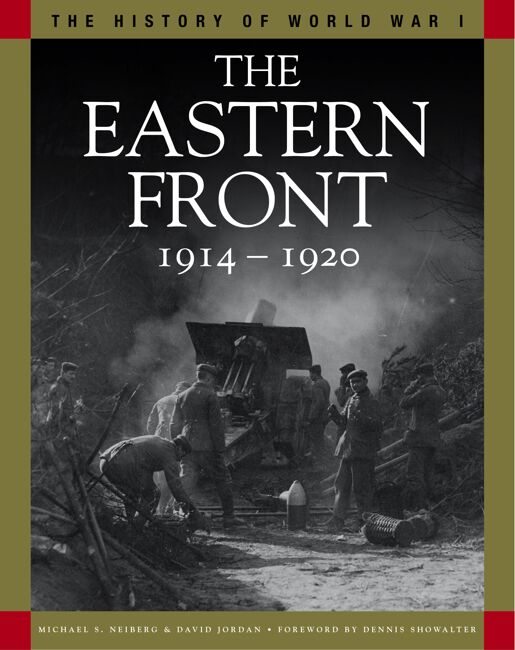The Eastern Front 1914-1920: History of WWI series
On the Western Front the fighting raged for nearly four and a half years, but this was only a part of what was truly a world war. From the Falkland Islands to the lakes of Africa, to the former German... Read moreRead less
On the Western Front the fighting raged for nearly four and a half years, but this was only a part of what was truly a world war. From the Falkland Islands to the lakes of Africa, to the former German colonies in the Pacific, and the battles along the Isonzo river in Italy, the six volumes in the World War I series recreate the battles and campaigns that raged on land, at sea and in the air.
In 1914, the autocratic Russian Empire was allied to the democracies of France and Great Britain – and the small Kingdom of Serbia – through a series of treaties concluded in the late nineteenth and early twentieth centuries, and designed to counter the threat of the Central Powers of Germany and Austria-Hungary.
With the outbreak of war in August, the Russian forces mobilized and moved into the attack. Despite being outnumbered, the German commander, Paul von Hindenburg, destroyed one Russian army at the Battle of Tannenberg in August 1914, before defeating another at the Battle of the Masurian Lakes the following month. The Russians fared better against the Austro-Hungarian forces further south in Galicia, before reluctant German intervention to help their allies stabilized the situation.
The year 1915 saw the German High Command switch their main effort to the Eastern Front, resulting in the decisive German victory at Gorlice-Tarnow, and the subsequent capture of Warsaw and hundreds of square miles of formerly Russian-controlled territory.
The Russian Brusilov Offensive in the summer of 1916 and the Romanian entry into the war on the Allied side saw the latter’s fortunes revive, but the success proved to be only temporary. Brusilov’s attack stalled, while Romania was effectively knocked out of the war by a joint Central Powers offensive led by Germany and Bulgaria.
Increasing unrest in Russia culminated in the first revolution of 1917 and the abdication of Tsar Nicholas II. The offensives of the Russian Provisional Government failed, and a second revolution in November saw Lenin’s Bolsheviks seize power. Having made peace with the Central Powers, the Bolsheviks fought the anti-Bolshevik ‘White’ Russian forces in the Civil War that followed, while a number of Allied powers sent forces to help the Whites. This conflict, combined with war with the newly-revived state of Poland in 1919, meant that large-scale fighting in Russia did not end until late 1920.
The length of the front in the East was much longer than in the West. The theatre of war was roughly delimited by the Baltic Sea in the West and Moscow in the East, a distance of 1,200 kilometres, and Saint Petersburg in the North and the Black Sea in the South, a distance of more than 1,600 kilometres. This had a drastic effect on the nature of the warfare. While World War I on the Western Front developed into trench warfare for much of the war, the battle lines on the Eastern Front were much more fluid, and trenches never truly developed.
The greater length of the front ensured that the density of soldiers in the line was lower so the line was easier to break. Once broken, the sparse communication networks made it difficult for the defender to rush reinforcements to the rupture in the line to mount a rapid counteroffensive and seal off a breakthrough. The terrain in the Eastern European theatre was quite solid, often making it near impossible to construct anything resembling the complicated trench systems on the Western Front, which tended to have muddier and much more workable terrain. In short, in the east the side defending did not have the overwhelming advantages it had on the Western Front. In fact the greatest advance of the whole war was made in the East by the German Army in the summer of 1915.
With the aid of over 300 black and white and colour photographs, complemented by full-colour maps, The Eastern Front provides a detailed guide to the background and conduct of the conflict on the Eastern Front, up to and including the Russian Civil War and the Russo-Polish War.
With the aid of over 300 black and white and colour photographs, many previously unpublished, the World War I series recreates the battles and campaigns that raged across the surface of the globe, on land, at sea and in the air. The text is complemented by full-colour maps that guide the reader through specific actions and campaigns.
History of World War I series
Format: 246 x 195mm pb
Extent: 224pp
Word count: 75,000
Illustrations: 150 b/w photos, 100 a/ws
ISBN: 9781838861308
9781838861179 pb US/Can
9781838861308 pb UK and ROW
9781908273079 epub
9781908273079 kindle
9781906626112 hb [out of print]
Buy now:
